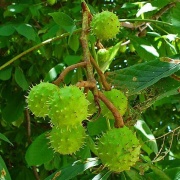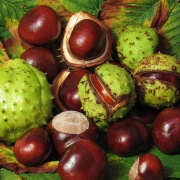Aesculus hippocastanum
Contents
Common Names
Horse Chestnut, Conker Tree
Family
Description
A large deciduous tree cultivated throughout temperate regions, the fruit has a spiky green shell containing 1-3 nuts (conkers).
| Foliage | deciduous |
| Group | broadleaf |
| Toxic Parts? | yes |
| Height | 15 - 35m |
| Crown Diameter | 20m |
| Crown Shape | domed |
| Shade Tree? | yes |
| Autumn Colour? | no |
| Age | 50-75 years |
| Time to Maturity | 45 - 50 years |
| Flower Colour | white |
| Fruit Colour | green |
| Bee Friendly? | yes |
Native Areas
Native to a small area in the Pindus Mountains mixed forests and Balkan mixed forests of South East Europe[1].
Preferred growing conditions
| Soil pH Range | 5 - 8.5 (acidic - slightly acidic - neutral - slightly alkaline ) |
| Soil Types | sand, silt, clay, loam, chalk |
| Drainage | well drained |
| Soil Fertility | |
| Sunshine | part sun and full sun |
| Soil Moisture | moist |
| Tolerates Exposure | yes |
| Growth Rate | - |
Hardiness
| RHS | USDA | EGF |
| H | 4B | H1 |
How to plant
Water container-grown and rootballed trees well and allow to drain an hour before planting. While it drains dig out an area for the tree that is about 2 to 3 times the diameter of the container or rootball and the same depth as the container or rootball. If the soil is compacted loosen with a fork (this includes the sides of the hole). But beware of having soil that is too loose on the bottom as this will cause the tree to be lower than desired upon watering.
- If container-grown, put the tree on its side and remove the container. Place in the hole and loosen the roots around the edges without breaking up the root ball too much. Check the depth by place a cane or stick across the diameter - only the root collar should be below and not the main stem.
- If planting a balled and burlapped tree, remove ties or nails from the burlap at the top of the ball and using a knife if necessary, pull the top of the burlap back, so it does not stick out of the hole when the soil is replaced. Synthetic burlap should be completely removed as it will not decompose. Note burlap sticking out of the hole can wick water away from the tree.
- For bareroot trees, feel the moisture of the roots by hand - if dry, dunk them in an bucket of water for 10-15 seconds and replace the packaging (if you are not going to plant at that time). Do not plant too deeply - only plant up to the root collar. i.e. the stem should not be covered in soil. Ensure roots are planted firmly and have good contact with the soil.
Fill in the hole with soil and compost, but do not add less than half of the original soil.
Using the soil, create a water ring around the outer edge of the hole. Not only does this conserve water, but it will also direct moisture to the perimeter roots, encouraging outer growth. Once the tree is established, the water ring may be levelled. Studies show that mulched trees grow faster than those unmulched, so add a 3 inch layer of pinestraw, compost, or pulverized bark over backfilled area.
Only prune lower damaged branches if necessary. Water newly planted trees regularly in their first year. Staking is also important in new trees and in exposed areas - a 1 m stake at 45 degrees crossing the stem at a height of 15 cm can provide good support. Be careful of the binding of the stake to ensure the tree is not strangled. Binding should be checked in the second year, as the stem will thicken.
When to plant
Early to mid-Autumn, for cold, wet sites wait until early to mid-Spring. Container-grown trees can generally be planted all year round except when it is very hot and dry or the ground is frozen.
Tree care
| Hedging Potential | no |
| Balcony/Roof Terrace | no |
| Indoors | no |
Potential Pests and Diseases
| Pests | horse chestnut scale, leaf-mining moths |
| Diseases | canker, coral spot, leaf spot |
Ecology
History and Human Connection
The common name "horse-chestnut" (often unhyphenated) is reported as having originated from the erroneous belief that the tree was a kind of chestnut (though in fact only distantly related), together with the observation that eating the fruit cured horses of chest complaints despite this plant being poisonous to horses [1]. A famous specimen of the horse-chestnut was the Anne Frank Tree in the centre of Amsterdam, which she mentioned in her diary and which survived until August 2010, when a heavy wind blew it over[1].
Uses
- Cultivated as a bonsai
- Medicinal: The seed extract standardized to around 20 percent aescin (escin) is used for its venotonic effect, vascular protection, anti-inflammatory and free radical scavenging properties. Indications are sprains and strains, edemas, chronic leg edema, hemorrhoids, varicose veins, and chronic venous insufficiency [1].
- The nuts are used in a children's game (conkers)
- Note these nuts are poisonous (especially to horses) and this tree is not to be confused with the edible Sweet Chestnut.
- As an ornamental flowering tree
- The seeds were previously used in France and Switzerland as a whitening agent for wool, hemp, flax and silk [1].
References






